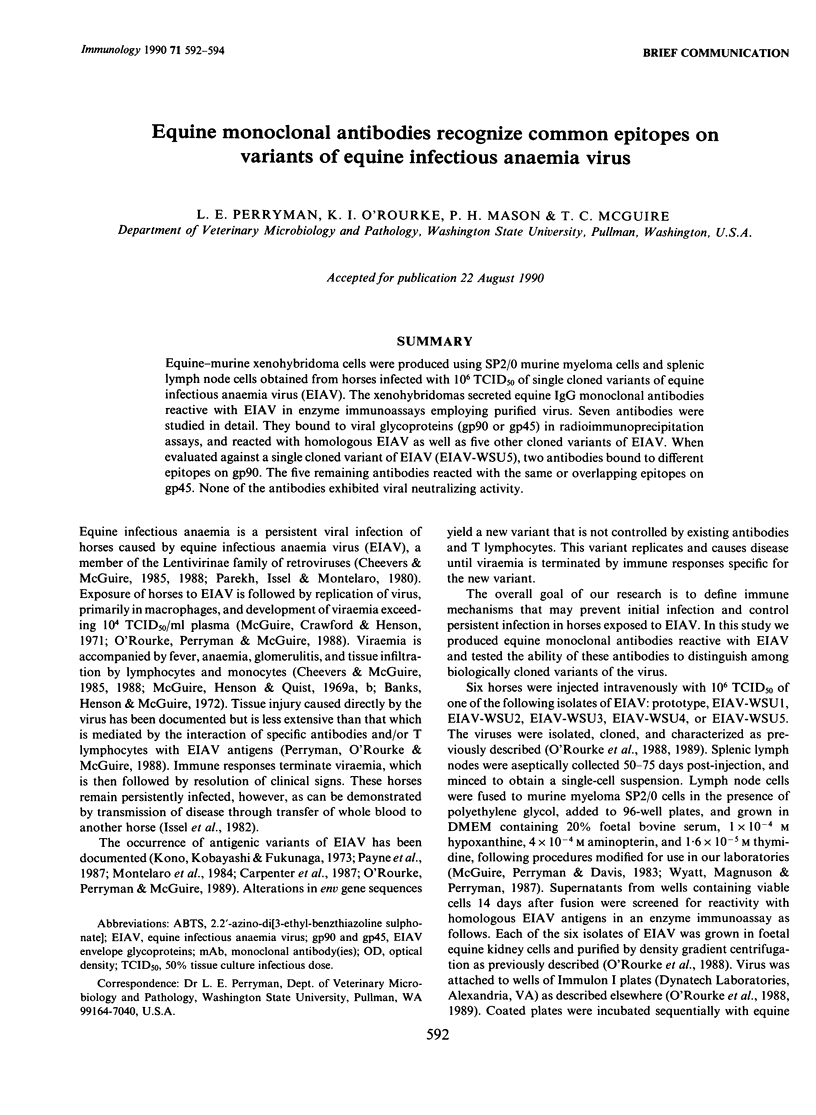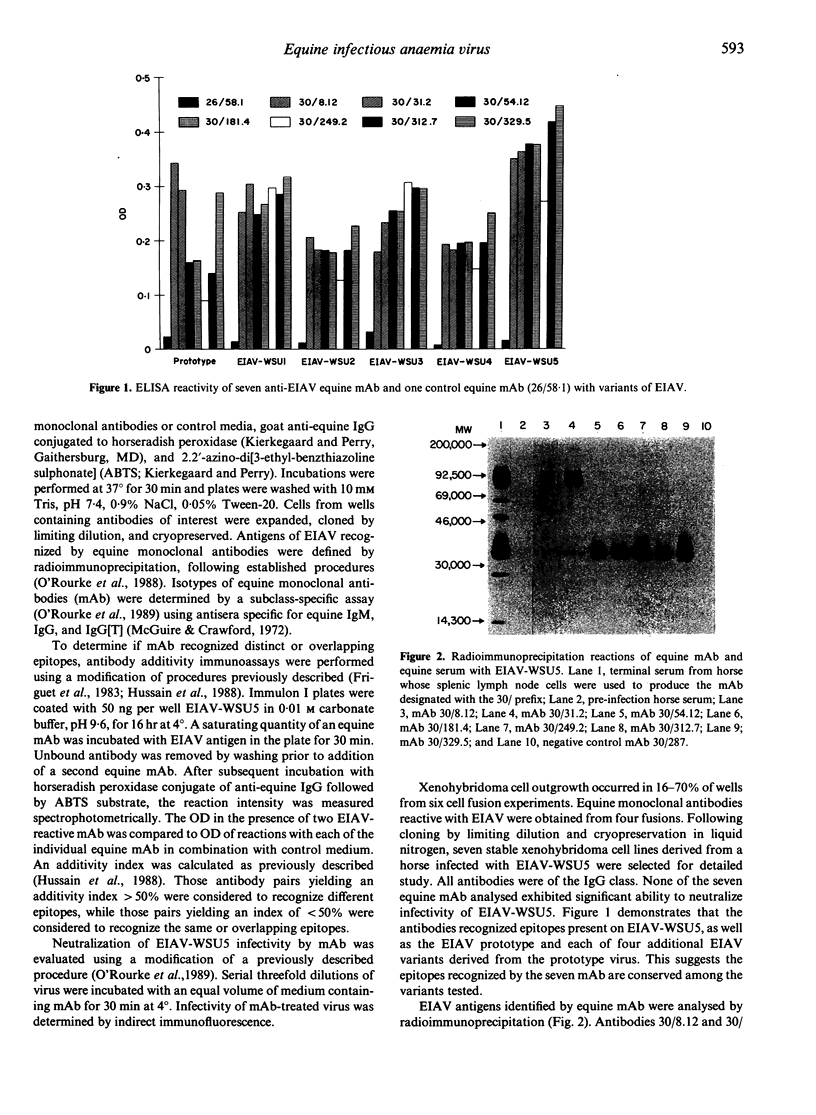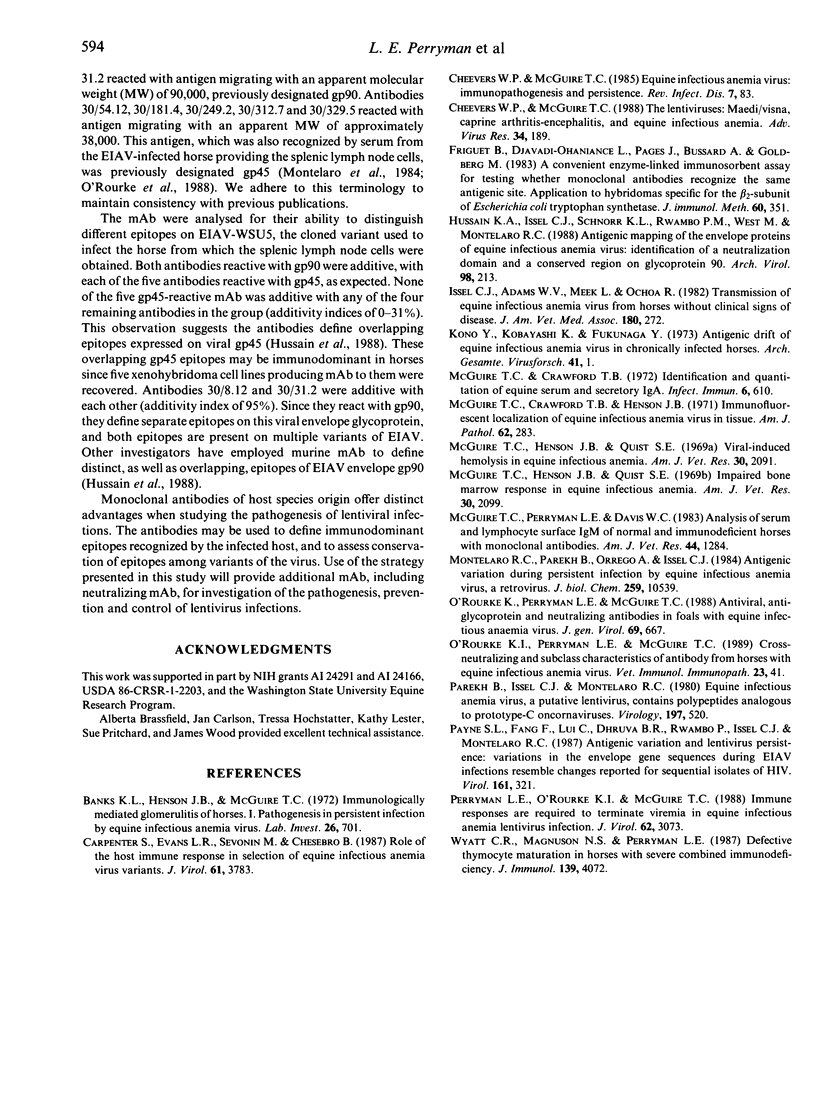Abstract
Equine-murine xenohybridoma cells were produced using SP2/0 murine myeloma cells and splenic lymph node cells obtained from horses infected with 10(6) TCID50 of single cloned variants of equine infectious anaemia virus (EIAV). The xenohybridomas secreted equine IgG monoclonal antibodies reactive with EIAV in enzyme immunoassays employing purified virus. Seven antibodies were studied in detail. They bound to viral glycoproteins (gp90 or gp45) in radioimmunoprecipitation assays, and reacted with homologous EIAV as well as five other cloned variants of EIAV. When evaluated against a single cloned variant of EIAV (EIAV-WSU5), two antibodies bound to different epitopes on gp90. The five remaining antibodies reacted with the same or overlapping epitopes on gp45. None of the antibodies exhibited viral neutralizing activity.
Full text
PDF


Images in this article
Selected References
These references are in PubMed. This may not be the complete list of references from this article.
- Banks K. L., Henson J. B., McGuire T. C. Immunologically mediated glomerulitis of horses. I. Pathogenesis in persistent infection by equine infectious anemia virus. Lab Invest. 1972 Jun;26(6):701–707. [PubMed] [Google Scholar]
- Carpenter S., Evans L. H., Sevoian M., Chesebro B. Role of the host immune response in selection of equine infectious anemia virus variants. J Virol. 1987 Dec;61(12):3783–3789. doi: 10.1128/jvi.61.12.3783-3789.1987. [DOI] [PMC free article] [PubMed] [Google Scholar]
- Cheevers W. P., McGuire T. C. Equine infectious anemia virus: immunopathogenesis and persistence. Rev Infect Dis. 1985 Jan-Feb;7(1):83–88. doi: 10.1093/clinids/7.1.83. [DOI] [PubMed] [Google Scholar]
- Cheevers W. P., McGuire T. C. The lentiviruses: maedi/visna, caprine arthritis-encephalitis, and equine infectious anemia. Adv Virus Res. 1988;34:189–215. doi: 10.1016/s0065-3527(08)60518-7. [DOI] [PubMed] [Google Scholar]
- Hussain K. A., Issel C. J., Schnorr K. L., Rwambo P. M., West M., Montelaro R. C. Antigenic mapping of the envelope proteins of equine infectious anemia virus: identification of a neutralization domain and a conserved region on glycoprotein 90. Arch Virol. 1988;98(3-4):213–224. doi: 10.1007/BF01322170. [DOI] [PubMed] [Google Scholar]
- Issel C. J., Adams W. V., Jr, Meek L., Ochoa R. Transmission of equine infectious anemia virus from horses without clinical signs of disease. J Am Vet Med Assoc. 1982 Feb 1;180(3):272–275. [PubMed] [Google Scholar]
- Kono Y., Kobayashi K., Fukunaga Y. Antigenic drift of equine infectious anemia virus in chronically infected horses. Arch Gesamte Virusforsch. 1973;41(1):1–10. doi: 10.1007/BF01249923. [DOI] [PubMed] [Google Scholar]
- McGuire T. C., Crawford T. B., Henson J. B. Immunofluorescent localization of equine infectious anemia virus in tissue. Am J Pathol. 1971 Feb;62(2):283–294. [PMC free article] [PubMed] [Google Scholar]
- McGuire T. C., Crawford T. B. Identification and quantitation of equine serum and secretory immunoglobulin A. Infect Immun. 1972 Oct;6(4):610–615. doi: 10.1128/iai.6.4.610-615.1972. [DOI] [PMC free article] [PubMed] [Google Scholar]
- McGuire T. C., Henson J. B., Quist S. E. Impaired bone marrow response in equine infectious anemia. Am J Vet Res. 1969 Dec;30(12):2099–2104. [PubMed] [Google Scholar]
- McGuire T. C., Henson J. B., Quist S. E. Viral-induced hemolysis in equine infectious anemia. Am J Vet Res. 1969 Dec;30(12):2091–2097. [PubMed] [Google Scholar]
- McGuire T. C., Perryman L. E., Davis W. C. Analysis of serum and lymphocyte surface IgM of healthy and immunodeficient horses with monoclonal antibodies. Am J Vet Res. 1983 Jul;44(7):1284–1288. [PubMed] [Google Scholar]
- Montelaro R. C., Parekh B., Orrego A., Issel C. J. Antigenic variation during persistent infection by equine infectious anemia virus, a retrovirus. J Biol Chem. 1984 Aug 25;259(16):10539–10544. [PubMed] [Google Scholar]
- O'Rourke K. I., Perryman L. E., McGuire T. C. Cross-neutralizing and subclass characteristics of antibody from horses with equine infectious anemia virus. Vet Immunol Immunopathol. 1989 Nov 30;23(1-2):41–49. doi: 10.1016/0165-2427(89)90108-6. [DOI] [PubMed] [Google Scholar]
- O'Rourke K., Perryman L. E., McGuire T. C. Antiviral, anti-glycoprotein and neutralizing antibodies in foals with equine infectious anaemia virus. J Gen Virol. 1988 Mar;69(Pt 3):667–674. doi: 10.1099/0022-1317-69-3-667. [DOI] [PubMed] [Google Scholar]
- Parekh B., Issel C. J., Montelaro R. C. Equine infectious anemia virus, a putative lentivirus, contains polypeptides analogous to prototype-C oncornaviruses. Virology. 1980 Dec;107(2):520–525. doi: 10.1016/0042-6822(80)90319-0. [DOI] [PubMed] [Google Scholar]
- Payne S. L., Fang F. D., Liu C. P., Dhruva B. R., Rwambo P., Issel C. J., Montelaro R. C. Antigenic variation and lentivirus persistence: variations in envelope gene sequences during EIAV infection resemble changes reported for sequential isolates of HIV. Virology. 1987 Dec;161(2):321–331. doi: 10.1016/0042-6822(87)90124-3. [DOI] [PubMed] [Google Scholar]
- Perryman L. E., O'Rourke K. I., McGuire T. C. Immune responses are required to terminate viremia in equine infectious anemia lentivirus infection. J Virol. 1988 Aug;62(8):3073–3076. doi: 10.1128/jvi.62.8.3073-3076.1988. [DOI] [PMC free article] [PubMed] [Google Scholar]
- Wyatt C. R., Magnuson N. S., Perryman L. E. Defective thymocyte maturation in horses with severe combined immunodeficiency. J Immunol. 1987 Dec 15;139(12):4072–4076. [PubMed] [Google Scholar]



